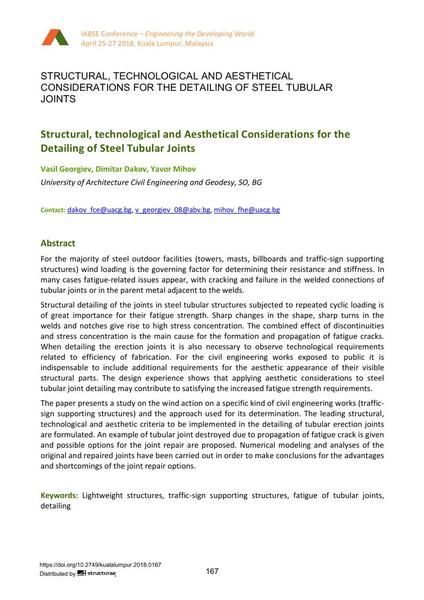Structural, technological and Aesthetical Considerations for the Detailing of Steel Tubular Joints

|
|
|||||||||||
Bibliographic Details
| Author(s): |
Vasil Georgiev Georgiev
(University of Architecture Civil Engineering and Geodesy, SO, BG)
Dimitar Dakov (University of Architecture Civil Engineering and Geodesy, SO, BG) Yavor Mihov (University of Architecture Civil Engineering and Geodesy, SO, BG) |
||||
|---|---|---|---|---|---|
| Medium: | conference paper | ||||
| Language(s): | English | ||||
| Conference: | IABSE Conference: Engineering the Developing World, Kuala Lumpur, Malaysia, 25-27 April 2018 | ||||
| Published in: | IABSE Conference Kuala Lumpur 2018 | ||||
|
|||||
| Page(s): | 167-174 | ||||
| Total no. of pages: | 8 | ||||
| DOI: | 10.2749/kualalumpur.2018.0167 | ||||
| Abstract: |
For the majority of steel outdoor facilities (towers, masts, billboards and traffic-sign supporting structures) wind loading is the governing factor for determining their resistance and stiffness. In many cases fatigue-related issues appear, with cracking and failure in the welded connections of tubular joints or in the parent metal adjacent to the welds. Structural detailing of the joints in steel tubular structures subjected to repeated cyclic loading is of great importance for their fatigue strength. Sharp changes in the shape, sharp turns in the welds and notches give rise to high stress concentration. The combined effect of discontinuities and stress concentration is the main cause for the formation and propagation of fatigue cracks. When detailing the erection joints it is also necessary to observe technological requirements related to efficiency of fabrication. For the civil engineering works exposed to public it is indispensable to include additional requirements for the aesthetic appearance of their visible structural parts. The design experience shows that applying aesthetic considerations to steel tubular joint detailing may contribute to satisfying the increased fatigue strength requirements. The paper presents a study on the wind action on a specific kind of civil engineering works (traffic- sign supporting structures) and the approach used for its determination. The leading structural, technological and aesthetic criteria to be implemented in the detailing of tubular erection joints are formulated. An example of tubular joint destroyed due to propagation of fatigue crack is given and possible options for the joint repair are proposed. Numerical modeling and analyses of the original and repaired joints have been carried out in order to make conclusions for the advantages and shortcomings of the joint repair options. |
||||
| Keywords: |
lightweight structures detailing traffic-sign supporting structures fatigue of tubular joints
|
||||
